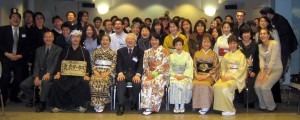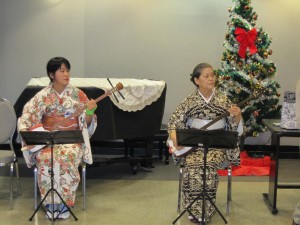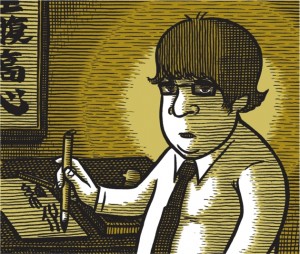JETs in the News: Lars Martinson featured in Japan Times article on ex-pat comics
********
JET alum/cartoonist Lars Martinson (Fukuoka-ken 2003-2006), author of the graphic novels Tonoharu: Part Two and Tonoharu: Part 1, is the focus (along with Adam Pasion, author of the Sundogs anthologies) of a thoughtful Japan Times article by Gianni Simone on comics about Japan “that tell it like it is.”
Here’s the link to the article: http://search.japantimes.co.jp/cgi-bin/fl20110205a1.html
And below are a few excerpts about Martinson from the article:
The comic life of expats in Japan
Americans Lars Martinson and Adam Pasion tell it like it is with cutting-edge manga
By GIANNI SIMONE Special to The Japan Times
Tales of expat life in Japan all too often get blown out of proportion and quickly become picaresque adventures that little resemble real life.
**********
Luckily for us, many comic artists who have lived here seem to be more level-headed and have tackled the subject with a more realistic, no-nonsense approach.
**********
As the title suggests, “Tonoharu: Part Two” is not Martinson’s first foray in the field of expat comics: He self-published the first volume of this four-part saga in 2008 thanks to a grant from the prestigious Xeric Foundation.
Martinson, 33, first arrived in Japan in 2003 to work as an assistant language teacher, and spent the next three years working at a junior high school in a small town in Fukuoka Prefecture. His second stint in this country was in 2008 when he studied East Asian calligraphy under the auspices of a two-year research scholarship from the Japanese government.
Travel had played a pivotal role in his life (he had lived in Thailand and Norway as well), so when he came up with the idea of producing a graphic novel, he decided to make foreign travel a central theme.
“I planned from the start to turn my Japanese experience into a comic,” Martinson says, “even though I didn’t want it to be a mere autobiographical story. So I chose a 20-something American like me as the protagonist, but added a fictional group of eccentric expatriates living in the same rural Japanese town.”
At times living in the middle of nowhere was a challenge. Still, Martinson has no regrets about those three years spent in Kyushu.
“I’m actually a city slicker,” confesses Martinson, “and would love to live in a huge city in Japan at some point. Also, I’m sure that expat communities are awesome, but they can also separate you from the native population. When you live out in the country, you don’t have the option to just hang out with other Westerners, and this can force you to get involved in the host culture in ways you probably wouldn’t otherwise.”
Click here to read the full article: http://search.japantimes.co.jp/cgi-bin/fl20110205a1.html
Click here to read more JetWit posts about Lars Martinson:
Click here for Lars Martinson’s official blog/website: http://larsmartinson.com
NYTimes column: “Dominating the Man Cave” by JET alum Bruce Feiler
 A thoughtful column in today’s New York Times on the topic of ESPN and man culture by JET alum Bruce Feiler, author of Learning to Bow, Walking the Bible and several other best-sellers including his recent book The Council of Dads:
A thoughtful column in today’s New York Times on the topic of ESPN and man culture by JET alum Bruce Feiler, author of Learning to Bow, Walking the Bible and several other best-sellers including his recent book The Council of Dads:
http://www.nytimes.com/2011/02/06/fashion/06ThisLife.html?_r=1&src=twrhp
WIT Life #152: Kaga Maki-e
WITLife is a periodic series written by professional Writer/Interpreter/Translator Stacy Smith (Kumamoto-ken CIR, 2000-03). She starts her day by watching Fujisankei’s newscast in Japanese, and here she shares some of the interesting tidbits and trends together with her own observations.
Recently I had the opportunity to interpret for a delegation from Kanazawa that was here to promote the city in general and especially its ancient craft of 蒔絵 (maki-e), a lacquerware technique that uses silver and gold powder. This art form actually originated in Kyoto which has its own style known as Kyo Maki-e, but the Kanazawa version is called Kaga Maki-e, Kaga referring to the area of Kanazawa where it originated. This picture, courtesy of fashion blogger Alice Chin, shows two delegation members at the ribbon cutting ceremony for the new Kaga Maki-e display.
On the left is native New Yorker and long-term Kanazawa resident Evelyn Teploff-Mugii, a designer who has modernized the thousand year old maki-e process to make breathtakingly beautiful accessories. Her Evelyn Claude line will be offered in the US for the first time. To her right is Read More
There’s a nice piece today by Dan Moeller on The Wide Island View (a really high-quality JET-produced webzine for Hiroshima-ken) looking into the similarities between the Philly Phanatic and Slyly, the Hiroshima Carp’s mascot. In the process, Dan comes to grips with the overlap and digs below the costume to reveal some interesting things about the two mascots:
http://www.wideislandview.com/2011/02/the-hiroshima-carp-and-slyly-their-mascot/
Correction: The Wide Island View is independent and not an official AJET publication, as previously stated. Thanks to Dan for pointing that out and apologies for the confusion.
JET alum Bruce Feiler’s TED talk on The Council of Dads (video)
JET alum Bruce Feiler, author of Learning to Bow, Walking the Bible and several other best-sellers including his recent book The Council of Dads, recently spoke in connection with the TED lecture series:
WIT Life #151: Fireworks from the Heart
WITLife is a periodic series written by professional Writer/Interpreter/Translator Stacy Smith (Kumamoto-ken CIR, 2000-03). She starts her day by watching Fujisankei’s newscast in Japanese, and here she shares some of the interesting tidbits and trends together with her own observations.
 Yesterday I had the chance to attend the ANA-sponsored screening of Fireworks from the Heart (おにいちゃんのハナビ), a sentimental film based on the true story of recent high school graduate Taro whose sister Hana suffers from leukemia. The family moves from Tokyo to Niigata for her treatment, a change that Taro resents as has has to leave junior high in the middle of his final year. Hana ends up being Read More
Yesterday I had the chance to attend the ANA-sponsored screening of Fireworks from the Heart (おにいちゃんのハナビ), a sentimental film based on the true story of recent high school graduate Taro whose sister Hana suffers from leukemia. The family moves from Tokyo to Niigata for her treatment, a change that Taro resents as has has to leave junior high in the middle of his final year. Hana ends up being Read More
WIT Life #150: Tiger Mask, Toshiba’s Strides and a Moncchichi Milestone
******************************************************
WITLife is a periodic series written by professional Writer/Interpreter/Translator Stacy Smith (Kumamoto-ken CIR, 2000-03). She starts her day by watching Fujisankei’s newscast in Japanese, and here she shares some of the interesting tidbits and trends together with her own observations.
Recent articles from the Wall Street Journal and the New York Times brings bright tidings from Japan in the midst of a new year which has started with PM Kan’s low popularity ratings and a still lagging economy. One WSJ article describes the recent phenomenon of the Tiger Mask movement. On Christmas Day last year, a gift of 10 school bags was left at a child welfare facility with a note signed by “Naoto Date.” This was a reference to a character from a popular 1960s manga and TV anime called Tiger Mask. Naoto Date was a wrestling hero who went by the name Tiger Mask and who had grown up in an orphanage.
This act of generosity made by someone adopting this name has inspired numerous copycat donations, and in total there have been Read More
I often encourage JET alums to learn to use a blog, and I’ve even done some “Learn to Blog” workshops for JET alums (and lawyers too) where I walk people through the set-up, the basics and some of the quirks.
Now there’s apparently a WordPress site that offers a tutorial for setting up a blog and using it. Just go to http://learn.wordpress.com/
Knowing how to use a blog is a great job/communication skill to have in this era. It’s also a great platform for promoting yourself and your skills serving as a portfolio for your abilities and accomplishments if you’re trying to make your way in the freelance world, or trying to bootstrap yourself into a full-time job.
And of course, if you ever want to write for JetWit, it’s extremely helpful on my end if there’s less explaining for me to do in order to enable you to get started contributing to the site.
So take a look if interested and let me know whether it’s helpful. (I haven’t actually reviewed any of the tutorials. But WordPress generally has good quality stuff.) Also note the somewhat JET-relevant title on the main page. :-)
–Steven Horowitz (Aichi-ken, 1992-94)
Founder & Publisher, JetWit.com
Brooklyn, NY
WIT Life #149: 成人の日
WITLife is a periodic series written by professional Writer/Interpreter/Translator Stacy Smith (Kumamoto-ken CIR, 2000-03). She starts her day by watching Fujisankei’s newscast in Japanese, and here she shares some of the interesting tidbits and trends together with her own observations.

Yesterday Japan celebrated 成人の日 (seijin no hi) or Coming of Age Day, and 1.24 million youngsters took part in this celebration (成人式 or seijinshiki). This was the lowest number of participants ever, and the fourth straight year in which the number of 20-year olds has declined. This morning’s news interviewed the 1500 or so Chiba youths who were lucky enough to have their ceremony at Disneyland. They were asked how they felt about becoming adults, and the majority expressed uncertainty regarding their future and being able to find jobs. This year’s group was born in 1990 when the economic bubble burst, and they have Read More
WIT Life #148: Mikarimba
WITLife is a periodic series written by professional Writer/Interpreter/Translator Stacy Smith (Kumamoto-ken CIR, 2000-03). She starts her day by watching Fujisankei’s newscast in Japanese, and here she shares some of the interesting tidbits and trends together with her own observations.
On Friday night I had the opportunity to see the performance of marimbist Mika Yoshida at Carnegie Hall. The program was entitled “Mikarimba Madness” and also featured drummer Steve Gadd and bassist Eddie Gomez, as well as the participation of special father/son guests clarinetist Richard Stoltzman and pianist Peter John Stoltzman. During the night Yoshida wore a wide range of expressions on her face from fierce to completely content, as she both Read More
JET alum shares perspectives of Japan in Metropolis magazine
 JET alum Mark Flanigan (Nagasaki 2000-04) wrote to JetWit to share his writing “debut” in Tokyo, featured in Metropolis Magazine. Following his stint in Nagasaki, Mark returned to Japan as a Rotary International World Peace Fellow at International Christian University (ICU) / 国際基督教大学 in Tokyo. He says:
JET alum Mark Flanigan (Nagasaki 2000-04) wrote to JetWit to share his writing “debut” in Tokyo, featured in Metropolis Magazine. Following his stint in Nagasaki, Mark returned to Japan as a Rotary International World Peace Fellow at International Christian University (ICU) / 国際基督教大学 in Tokyo. He says:
I am very happy and also humbled to have been selected to write for such a great magazine. In my article, I talk about some of the different impressions I have found here, as a JET and now as a Peace Fellow, and compare/contrast my feelings of my two different times spent living in Japan.
Click here to read the article, “Found and Lost: Reflections on my two Japans.”
WITLife is a periodic series written by professional Writer/Interpreter/Translator Stacy Smith (Kumamoto-ken CIR, 2000-03). She starts her day by watching Fujisankei’s newscast in Japanese, and here she shares some of the interesting tidbits and trends together with her own observations.
Last night I attended the shinnenkai for New York’s very own Battenkai, or group for Kyushu people (Batten comes from Kyushu-ben and means but, and kai means gathering). There are several kenjinkai or prefectural groups here in the city, but Kyushu has this joint group instead of individual ones for each prefecture. I have been attending their events since two summers ago, and it is always a diverse mix of people. You can find accountants, jazz singers, lawyers, graphic designers and karate instructors, all of whom have interesting stories to share.
Battenkai gatherings always include some form of entertainment, and last night’s was no exception. It featured several different acts to welcome the new year. First we were regaled by a beautiful shamisen performance by Read More
JET alum/cartoonist Lars Martinson gives radio interview
Check out this great radio interview with JET alum/cartoonist Lars Martinson (Fukuoka-ken 2003-2006), creator of the four-part graphic novel Tonoharu. Lars talked with radio station KFAI out Minnesota in December. Hear him talk about the creation of his book, which tells the tale of an ALT wrestling with the challenges of living in rural Japan (sound familiar, anyone?). Lars lived in rural Fukuoka for three years and spent several years post-JET crafting the novel based on his experiences.
For those who are interested, Tonoharu Part I and Part II (which just hit book shelves in November) can be found here:
Also be sure to check out JetWit’s recent interview with Lars Martinson.
WIT Life #146: 明けましておめでとうございます!
WITLife is a periodic series written by professional Writer/Interpreter/Translator Stacy Smith (Kumamoto-ken CIR, 2000-03). She starts her day by watching Fujisankei’s newscast in Japanese, and here she shares some of the interesting tidbits and trends together with her own observations.
A big akemashite omedetou gozaimasu to everyone! 今年もよろしくお願いいたします。 I hope everyone had a good end to the year and that you are feeling ready for the Year of the Rabbit that we have now entered. I spent the night of 元旦 (gantan) or New Year’s Day with co-workers from the Japanese restaurant that I used to waitress at, and we enjoyed osechi ryouri in lacquer boxes and bowls of ozouni as we watched 紅白歌合戦 (kouhaku uta gassen) or the Red and White Singing Contest. The white or men’s team won for the 6th consecutive year with a healthy margin of over 50,000 votes.
Aside from the usual vapid J-Pop and classic enka, I was really struck by singer Kana Uemura’s トイレの神様 (toire no kamisama), or The Toilet Goddess. This acoustic ballad is a whopping almost ten minutes long, and it tells the story of Read More
WIT Life #145: Manga studies
WITLife is a periodic series written by professional Writer/Interpreter/Translator Stacy Smith (Kumamoto-ken CIR, 2000-03). She starts her day by watching Fujisankei’s newscast in Japanese, and here she shares some of the interesting tidbits and trends together with her own observations.
Coming off of yesterday’s post, I was surprised to find an article about manga and animation in this morning’s New York Times. It discusses how over the last decade, various programs that have evolved for formally studying these arts are attracting international students. The courses are offered only in Japanese which presents a bit of a challenge, but dedicated students see them as the key to advancing “their careers in animation, design, computer graphics and the business of promoting them.” The Japanese animation companies interviewed in the article said Read More



